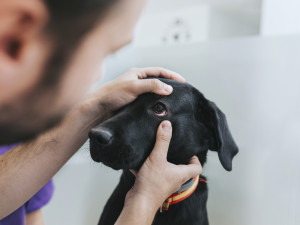How to Manage Eye Inflammation in Dogs
This natural remedy may prove to be a key for managing symptoms without side effects.

share article
Many of the medications that improve our daily lives were first found in nature—the discovery of aspirin began with willow tree bark, penicillin was first extracted from a common species of mold, and countless other life-improving compounds have roots in the natural world. Dr. Erin Scott, an assistant professor at the Texas A&M College of Veterinary Medicine & Biomedical Sciences, has found inspiration in the turmeric plant, a member of the ginger family known for its vivid yellow color that may have powerful anti-inflammatory properties useful in the treatment of uveitis in dogs.
What is Uveitis?
Uveitis is a common eye disorder in dogsopens in a new tab where inflammation inside a dog’s eye causes discomfort and sensitivity to light. “It occurs commonly in dogs and has many causes. We can see uveitis secondary to infectious diseases, canceropens in a new tab, and auto-immune diseases. Uveitis can also occur with longstanding cataractsopens in a new tab and after cataract surgery is performed,” Scott says.
Uveitis is a leading cause of complications after cataract surgery in dogs, Scott says, and the management of postoperative inflammation inside the eye is a major challenge in both veterinary and human ophthalmology.
Symptoms of Uveitis in Dogs
Ocular pain
Reddening of the dog’s eye
Excessive squinting
Avoiding bright lights
Cloudy appearance in the dog’s eye
A pet parent might suspect their dog has this condition if they keep their affected eye shut by squinting and avoiding bright lights. Your pup’s eye may also appear cloudy or exhibit excessive tearing.
How Do You Treat Uveitis?
“Current treatments for canine uveitis include a combination of systemic and topical anti-inflammatory medications, either in the form of steroids or non-steroidal anti-inflammatory drugs (NSAIDs),” Scott says.
While these medications are effective in the treatment of uveitis, they can cause unwanted side effects such as vomiting, diarrhea, stomach ulcers, negatively impact kidney and liver function, and increase glucose levels in diabetic patients.
Natural Treatment for Uveitis in Dogs
That’s why Scott and her colleagues have investigated the anti-inflammatory properties of curcumin, a compound found in turmeric, and discovered that when processed to a special nanoparticle formulation that boosts absorption, this natural compound is safe and effective at managing uveitis without any known side effects.
Though the nanoparticle formulation of curcumin used by Scott in her research is not yet available to the public, she is optimistic that her findings will lead to advances in the management of uveitis for both humans and dogs. For now, pet parents who suspect their dog is suffering from uveitis should contact their veterinarian, who will help determine the most current and best path of treatment for their furry friend.
“This formulation is something to look for in the future, as further testing is necessary for us to confirm our findings. At this time, pet parents should follow the recommendations of their veterinary care professional,” Scott says, “We do hope to start a clinical trial with this new medication in the near future.”

Jennifer Gauntt
Jennifer Gauntt, MA, is the communications director at Texas A&M University College of Veterinary Medicine & Biomedical Sciences, where she covers scientific advancements in pet heath and behavior. This story was originally published by Pet Talk, a service of the College of Veterinary Medicine & Biomedical Sciences, Texas A&M University. Original stories can be viewed on the web at vetmed.tamu.edu/news/pet-talkopens in a new tab. May be edited for style and length.
Related articles
![close up of Chihuahua dog's eye with cataracts]() opens in a new tab
opens in a new tabCommon Eye Problems in Dogs and How to Treat Them
Your dog sees you as their best friend, so keep those eyes healthy.
![Jack Russel Terrier mixed breed dog laying on his back on a white and gray rug getting his belly rubbed by his owner]() opens in a new tab
opens in a new tabHow to Do a DIY Dog Checkup in 7 Steps
You can do a DIY exam on your dog from your couch.
![Small black pug in a red banana sitting in grass and looking up at camera, dogs eyes getting cloudy]() opens in a new tab
opens in a new tabEverything You Need to Know About Cataracts in Dogs
Here’s how to spot the eye condition and help your dog see more clearly.
![Dog laying his head on owners lap while owner holds his ears.]() opens in a new tab
opens in a new tabDIY Physical Exam Part 2 — How to Check Your Dog for Infections
Veterinarian Dr. Shea Cox on how to assess your dog’s eyes, ears, nose, and mouth.




